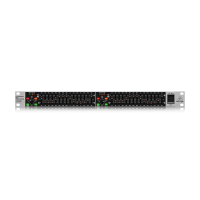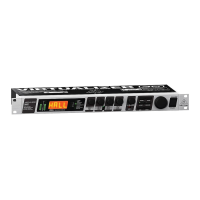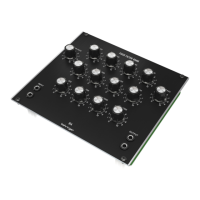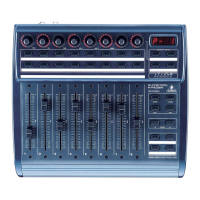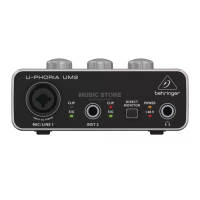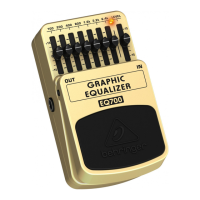course, music or noise has to be present in the room for this to work).
(3) PANIC – If unexpected feedback starts occurring during a performance, pressing the PANIC button can help. As
long as the button is kept pressed (for a maximum of 1 second), your FBQ2496 rapidly searches for feedback
frequencies and suppresses them.
(4) SPEECH – Pressing the SPEECH button increases the sensitivity of feedback suppression; the FBQ2496
recognizes critical frequencies sooner and deploys a filter that cuts inappropriately.
(5) FREEZE – Once a particularly good FBQ2496 setting is achieved, you can keep this setting by pressing the
FREEZE button. All Single-Shot and automatic filters are kept at their settings until you press FREEZE again.
(6) FILTER LIFT – The so-called “Filter Lifting Time” informs you about how long an adjusted automatic filter can
remain inactive before its values are reset again. You can set this time by first briefly pressing the FILTER LIFT
button and then turning the wheel. The following time lengths are available: 0 min, 1 min, 5 min, 10 min, 30 min, 60
min.
(7) RESET – If you briefly press the RESET button, all automatically set filters are erased. If you keep the RESET
button pressed longer, Single Shot filters are erased as well. In PEQ mode, briefly pressing the RESET button
erases the selected filter. Keeping the RESET button pressed longer erases all the parametric filters all at once.
(8) STATUS DISPLAY – The FBQ2496 features a total of 40 filters, i.e. 20 filters per channel. They can be
monitored and controlled on the STATUS DISPLAY.
(9) LED DISPLAY – The three-digit numeric display indicates the absolute value of the parameter you are modifying.
(10) GAIN – In the PEQ mode, the GAIN button lets you adjust filter gain in dB (from +15 dB to
-15 dB in 0.5-dB increments, and from -16 dB to -36 dB in 1-dB increments). The dB value set using the wheel is
shown in the display.
(11) PEQ After keeping the PEQ button pressed for a few moments (the LED on the PEQ button blinks), use the
wheel to set the number of parametric filters. They start with filter number 20 and can go down to filter number 1, step
by step. At the same time, the already set Single-Shot filters are shown.
If you only briefly press the PEQ button (the LED on the PEQ button is lit), any filter can be called up using the wheel.
The number of the selected filter is shown in the display, and the corresponding filter LED blinks. Amplification,
bandwidth, and mid-frequency parameters can now be shown.
(12) FREQUENCY – When the FBQ2496 is in the PEQ mode (the LED on the PEQ button is lit), the mid-frequency
of each individual filter can be set. To modify the mid-frequency, press the FREQUENCY button. The frequency
range can vary from 20 Hz to 20 kHz.
(13) LEFT-RIGHT – The LEFT-RIGHT button lets you select the channels you wish to edit.
(14) BANDWIDTH – Use the BANDWIDTH button to set the bandwidth (Q-factor/quality) of the selected parametric
filter. The adjustable filter quality encompasses a range from 1/60th of an octave up to 10 octaves. The FBQ2496
has to be in PEQ mode (the LED on the PEQ button is lit).
(15) BYPASS – Keeping the BYPASS button pressed for a few moments activates the hard bypass. The unit’s input
is directly routed to the output and the filters are bypassed.
(16) MIDI– Simultaneously pressing BANDWIDTH and BYPASS gets you into the MIDI menu (both button LEDs
are lit).
(17) WHEEL – WHEEL is a continuous rotary control. Use it to make adjustments to the selected parameter.
(18) POWER
(19) The mains connection is established using a cable with an IEC mains connector. An appropriate mains cable is
included.
(20) You can replace fuses at the FUSE SWITCH of the FBQ2496. Always replace fuses with the same type.
(21) The FBQ2496 features a complete set of MIDI functions. In addition to the usual MIDI IN and MIDI OUT ports,
